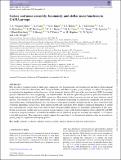Files in this item
Galaxy and mass assembly : luminosity and stellar mass functions in GAMA groups
Item metadata
| dc.contributor.author | Vazquez-Mata, J. A. | |
| dc.contributor.author | Loveday, J. | |
| dc.contributor.author | Riggs, S. D. | |
| dc.contributor.author | Baldry, I. K. | |
| dc.contributor.author | Davies, L. J. M. | |
| dc.contributor.author | Robotham, A. S. G. | |
| dc.contributor.author | Holwerda, B. W. | |
| dc.contributor.author | Brown, M. J. | |
| dc.contributor.author | Cluver, M. E. | |
| dc.contributor.author | Wang, L. | |
| dc.contributor.author | Alpaslan, M. | |
| dc.contributor.author | Bland-Hawthorn, J. | |
| dc.contributor.author | Brough, S. | |
| dc.contributor.author | Driver, S. P. | |
| dc.contributor.author | Hopkins, A. M. | |
| dc.contributor.author | Taylor, E. N. | |
| dc.contributor.author | Wright, A. H. | |
| dc.date.accessioned | 2020-12-07T15:59:25Z | |
| dc.date.available | 2020-12-07T15:59:25Z | |
| dc.date.issued | 2020-11 | |
| dc.identifier | 271534874 | |
| dc.identifier | aff181c9-95c4-4efa-91f7-15797f7a9e9d | |
| dc.identifier | 000587761200047 | |
| dc.identifier | 85098595129 | |
| dc.identifier.citation | Vazquez-Mata , J A , Loveday , J , Riggs , S D , Baldry , I K , Davies , L J M , Robotham , A S G , Holwerda , B W , Brown , M J , Cluver , M E , Wang , L , Alpaslan , M , Bland-Hawthorn , J , Brough , S , Driver , S P , Hopkins , A M , Taylor , E N & Wright , A H 2020 , ' Galaxy and mass assembly : luminosity and stellar mass functions in GAMA groups ' , Monthly Notices of the Royal Astronomical Society , vol. 499 , no. 1 , pp. 631-652 . https://doi.org/10.1093/mnras/staa2889 | en |
| dc.identifier.issn | 0035-8711 | |
| dc.identifier.uri | https://hdl.handle.net/10023/21116 | |
| dc.description | JAVM was supported by the Mexican National Council for Science and Technology (CONACYT) scholarship scheme. JL (ORCID 0000-0001-5290-8940) acknowledges support from the Science and Technology Facilities Council (STFC; grant number ST/I000976/1). SDR is supported by an STFC studentship. | en |
| dc.description.abstract | How do galaxy properties (such as stellar mass, luminosity, star formation rate, and morphology) and their evolution depend on the mass of their host dark matter halo? Using the Galaxy and Mass Assembly group catalogue, we address this question by exploring the dependence on host halo mass of the luminosity function (LF) and stellar mass function (SMF) for grouped galaxies subdivided by colour, morphology, and central/satellite. We find that spheroidal galaxies in particular dominate the bright and massive ends of the LF and SMF, respectively. More massive haloes host more massive and more luminous central galaxies. The satellites LF and SMF, respectively, show a systematic brightening of characteristic magnitude, and increase in characteristic mass, with increasing halo mass. In contrast to some previous results, the faint-end and low-mass slopes show little systematic dependence on halo mass. Semi-analytic models and simulations show similar or enhanced dependence of central mass and luminosity on halo mass. Faint and low-mass simulated satellite galaxies are remarkably independent of halo mass, but the most massive satellites are more common in more massive groups. In the first investigation of low-redshift LF and SMF evolution in group environments, we find that the red/blue ratio of galaxies in groups has increased since redshift z ≈ 0.3 relative to the field population. This observation strongly suggests that quenching of star formation in galaxies as they are accreted into galaxy groups is a significant and ongoing process. | |
| dc.format.extent | 22 | |
| dc.format.extent | 5643071 | |
| dc.language.iso | eng | |
| dc.relation.ispartof | Monthly Notices of the Royal Astronomical Society | en |
| dc.subject | Galaxies: evolution | en |
| dc.subject | Galaxies: groups: general | en |
| dc.subject | Galaxies: luminosity function, mass function | en |
| dc.subject | QC Physics | en |
| dc.subject | QB Astronomy | en |
| dc.subject | NDAS | en |
| dc.subject.lcc | QC | en |
| dc.subject.lcc | QB | en |
| dc.title | Galaxy and mass assembly : luminosity and stellar mass functions in GAMA groups | en |
| dc.type | Journal article | en |
| dc.contributor.institution | University of St Andrews. School of Physics and Astronomy | en |
| dc.identifier.doi | https://doi.org/10.1093/mnras/staa2889 | |
| dc.description.status | Peer reviewed | en |
This item appears in the following Collection(s)
Items in the St Andrews Research Repository are protected by copyright, with all rights reserved, unless otherwise indicated.

